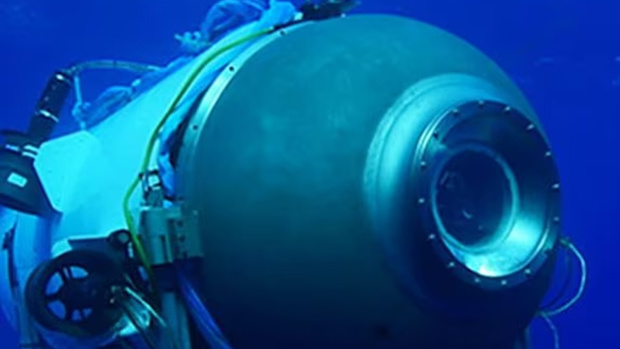All five onboard missing Titanic submarine have died in ‘catastrophic implosion’, it has been revealed

Photo / AP
The search for the missing Titanic submersible has ended in tragedy, with Coast Guard officials saying it suffered a “catastrophic implosion” that killed the five passengers onboard.
OceanGate, which owns the Titan submersible, issued a statement saying: “We now believe that our CEO Stockton Rush, Shahzada Dawood and his son Suleman Dawood, Hamish Harding, and Paul-Henri Nargeolet, have sadly been lost.
“These men were true explorers who shared a distinct spirit of adventure, and a deep passion for exploring and protecting the world’s oceans. Our hearts are with these five souls and every member of their families during this tragic time. We grieve the loss of life and joy they brought to everyone they knew.This is an extremely sad time for our dedicated employees who are exhausted and grieving deeply over this loss.”
The search for a missing submersible with five people aboard had taken a bleak turn with the US Coast Guard saying a debris field has been found at the bottom of the ocean near the Titanic, an announcement that came after the critical 96-hour mark when breathable air could have run out.
Rear Admiral John Mauger, who is leading the operation, previously had told Sky News that the team has ROVs “that are working along the path line where the planned dive had taken place for the Titan submersible”.
The Titan was estimated to have about a four-day supply of breathable air when it launched Sunday morning in the North Atlantic — but experts have emphasised that was an imprecise approximation to begin with and could be extended if passengers have taken measures to conserve breathable air. And it’s not known if they survived since the sub’s disappearance.
Rescuers have rushed ships, planes and other equipment to the site of the disappearance. On Thursday, the US Coast Guard said an undersea robot sent by a Canadian ship had reached the sea floor, while a French research institute said a deep-diving robot with cameras, lights and arms also joined the operation.

A 2004 photo shows the remains of a coat and boots in the mud on the sea bed near the Titanic's stern. Photo / Center for Archaeological Oceanography, University of Rhode Island, NOAA Office of Ocean Exploration, File
Authorities hoped underwater sounds might help narrow their search, whose coverage area has been expanded to thousands of miles — twice the size of Connecticut and in waters 4km deep. Coast Guard officials said underwater noises were detected in the search area Tuesday and Wednesday.
Jamie Pringle, an expert in Forensic Geosciences at Keele University, in England, said even if the noises came from the submersible, “The lack of oxygen is key now; even if they find it, they still need to get to the surface and unbolt it.”

The Titan was reported overdue Sunday afternoon about 700km south of St John’s, Newfoundland, as it was on its way to where the iconic ocean liner sank more than a century ago. OceanGate Expeditions, which is leading the trip, has been chronicling the Titanic’s decay and the underwater ecosystem around it via yearly voyages since 2021.
By Thursday morning (late Thursday night NZT), hope was running out that anyone on board the vessel would be found alive.
Many obstacles still remained: from pinpointing the vessel’s location, to reaching it with rescue equipment, to bringing it to the surface — assuming it was still intact. And all that has to happen before the passengers’ oxygen supply runs out.
Dr Rob Larter, a marine geophysicist with the British Antarctic Survey, emphasised the difficulty of even finding something the size of the sub — which is about 6.5m long and nearly 3m high.  A massive search was launched after contact was lost with the Titan submersible. Photo / OceanGate
A massive search was launched after contact was lost with the Titan submersible. Photo / OceanGate
“You’re talking about totally dark environments”, in which an object several dozen feet away can be missed, he said. “It’s just a needle in a haystack situation unless you’ve got a pretty precise location.”
Newly uncovered allegations suggest there had been significant warnings made about vessel safety during the submersible’s development.
Broadcasters around the world started newscasts at the critical hour Thursday with news of the submersible. The Saudi-owned satellite channel Al Arabiya showed a clock on air counting down to its estimate of when the air could potentially run out.
Captain Jamie Frederick of the First Coast Guard District said a day earlier that authorities were still holding out hope of saving the five passengers onboard.
Lost aboard the vessel is pilot Stockton Rush, the CEO of OceanGate. His passengers are: British adventurer Hamish Harding; Pakistani businessman Shahzada Dawood and his son Suleman; and French explorer and Titanic expert Paul-Henry Nargeolet.
In the first comments from Pakistan since the Titan vanished, Pakistani Foreign Ministry spokesperson Mumtaz Zahra said Thursday that officials have confidence in the search efforts.
“We would not like to speculate on the circumstances of this incident and we would also like to respect the wishes of the Dawood family that their privacy may be respected,” she said.
At least 46 people successfully travelled on OceanGate’s submersible to the Titanic wreck site in 2021 and 2022, according to letters the company filed with a US District Court in Norfolk, Virginia, that oversees matters involving the Titanic shipwreck.
One of the company’s first customers characterised a dive he made to the site two years ago as a “kamikaze operation”.
“Imagine a metal tube a few metres long with a sheet of metal for a floor. You can’t stand. You can’t kneel. Everyone is sitting close to or on top of each other,” said Arthur Loibl, a retired businessman and adventurer from Germany. “You can’t be claustrophobic.”
During the 2.5-hour descent and ascent, the lights were turned off to conserve energy, he said, with the only illumination coming from a fluorescent glow stick.
The dive was repeatedly delayed to fix a problem with the battery and the balancing weights. In total, the voyage took 10.5 hours.
The submersible had seven backup systems to return to the surface, including sandbags and lead pipes that drop off, and an inflatable balloon.
Nicolai Roterman, a deep-sea ecologist and lecturer in marine biology at the University of Portsmouth, England, said the disappearance of the Titan highlights the dangers and unknowns of deep-sea tourism.
“I think it is important to remember that to us humans, the deep sea is a very inhospitable place,” he said.
“Even the most reliable technology can fail, and therefore accidents will happen. With the growth in deep-sea tourism, we must expect more incidents like this.”
This article was first published by the NZ Herald and is republished here with permission.
Take your Radio, Podcasts and Music with you

